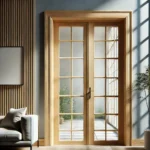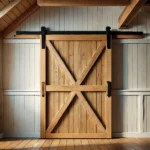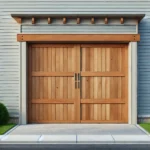Interior doors play a crucial role in defining the character and functionality of a home. Often overlooked in favor of furniture or wall decor, these essential components serve as much more than passageways between rooms. They shape the aesthetics of a space, provide privacy, and contribute to the overall ambiance of a home. With countless styles, materials, and designs available, interior doors have become a key element in modern interior design.
One of the most significant aspects of interior doors is their ability to seamlessly blend functionality with aesthetics. They are not just barriers; they are integral parts of the interior design that can enhance the look and feel of any room. Whether you prefer a classic wooden door, a sleek glass panel, or a minimalist flush design, there are endless possibilities to suit every taste. Interior doors can act as statement pieces or blend harmoniously into the background, depending on the design intent.
Material selection is a critical factor when choosing interior doors. The type of material not only determines the door’s appearance but also its durability and acoustic properties. Wooden interior doors, for instance, are highly popular due to their timeless appeal and versatility. They can be stained, painted, or left in their natural state to complement various design styles. Solid wood doors also provide excellent sound insulation, making them ideal for bedrooms, home offices, or spaces requiring privacy.
For homeowners seeking a more contemporary look, glass interior doors offer an excellent alternative. These doors allow natural light to flow between rooms, creating an open and airy atmosphere. Frosted or textured glass provides privacy while still letting light pass through, making them a practical option for bathrooms or home offices. Metal-framed glass doors, a growing trend in industrial-style interiors, add a bold and modern touch to spaces.
Interior doors also play a significant role in defining spatial boundaries. Pocket doors and sliding doors, for example, are ideal for maximizing space in smaller homes or apartments. These designs are perfect for areas where swing doors might be impractical, such as closets, bathrooms, or narrow hallways. Additionally, barn doors have gained popularity for their rustic charm and ability to add character to both traditional and contemporary interiors.
The design of interior doors extends beyond their basic function. Details such as paneling, molding, and hardware can elevate the look of a door and add depth to a room’s decor. Panel doors, with their classic rectangular or square designs, are a versatile choice that complements various architectural styles. Flush doors, with their smooth and flat surfaces, are ideal for modern and minimalist interiors. For a more decorative option, French doors with multiple glass panels create an elegant and timeless aesthetic.
Color and finish also play a significant role in the design of interior doors. A carefully chosen finish can make a door a standout feature or allow it to blend seamlessly with the walls. Neutral colors like white, beige, or gray are popular for their versatility, while bold hues can add a touch of personality and drama. Wood stains and natural finishes highlight the grain and texture of the material, adding warmth and richness to a space.
In addition to their visual appeal, interior doors contribute to the functionality of a home. Soundproofing is one of the key considerations, particularly in busy households or shared living spaces. Solid-core doors are effective in reducing noise transmission, ensuring that each room offers a quiet and private environment. This feature is particularly valuable for bedrooms, nurseries, and home offices where minimal disturbance is essential.
Thermal insulation is another benefit offered by well-designed interior doors. They help maintain consistent temperatures within rooms, contributing to energy efficiency. For homes in regions with extreme climates, interior doors can play a part in regulating indoor conditions, making them a practical addition to any energy-conscious household.
Customizability is another advantage of interior doors. Many manufacturers offer made-to-measure options, allowing homeowners to select specific dimensions, materials, and designs to meet their unique needs. This level of customization ensures that the doors not only fit perfectly but also enhance the overall design scheme. Custom interior doors are especially useful in older homes where non-standard door sizes are common.
Maintenance is an essential aspect of keeping interior doors looking and functioning their best. Regular cleaning, along with periodic refinishing for wooden doors, helps preserve their appearance and extend their lifespan. For glass doors, using appropriate cleaning products ensures clarity and prevents streaks. Meanwhile, inspecting and tightening hardware like hinges and handles ensures that the doors operate smoothly over time.
Sustainability has become an important consideration in the selection of interior doors. Eco-conscious homeowners are increasingly seeking doors made from responsibly sourced materials. Many manufacturers now use certified wood or recycled materials to produce environmentally friendly options. Additionally, low-VOC finishes and paints are available, contributing to healthier indoor air quality.
Interior doors also serve as an opportunity for homeowners to express their personal style. Whether through intricate carvings, artistic glass designs, or unique hardware, these doors allow for creative expression. Adding distinctive handles, knobs, or hinges can further personalize the look of a door, enhancing its character and charm.
In open-plan homes, interior doors can be used strategically to create flexible spaces. Sliding or folding doors, for instance, allow rooms to be opened up for gatherings or divided for more intimate settings. This adaptability is particularly valuable in modern homes where multifunctional spaces are common. Interior doors, therefore, not only define boundaries but also enable versatility in how spaces are used.
The use of interior doors is not limited to residential settings. In commercial spaces, they play an equally vital role. Office interiors, for example, benefit from acoustic doors that ensure privacy during meetings. Glass partitions with sliding doors create a sense of openness while maintaining functionality. Retail stores and hospitality establishments often incorporate custom-designed doors that align with their branding and overall aesthetic.
Ultimately, the choice of interior doors can significantly influence the overall ambiance and functionality of a home or space. They bridge the gap between architecture and interior design, serving as both practical elements and visual highlights. Thoughtful selection and placement of interior doors can transform a house into a cohesive and inviting home, reflecting the personality and lifestyle of its occupants.
By combining style, functionality, and sustainability, interior doors continue to evolve as essential components of modern design. They are not merely functional elements but integral parts of a well-thought-out living environment. Whether renovating an existing space or designing a new one, choosing the right interior doors is a decision that can leave a lasting impression on the home’s overall appeal.
![]()






4 thoughts on “Enhancing Home Design with Interior Doors”